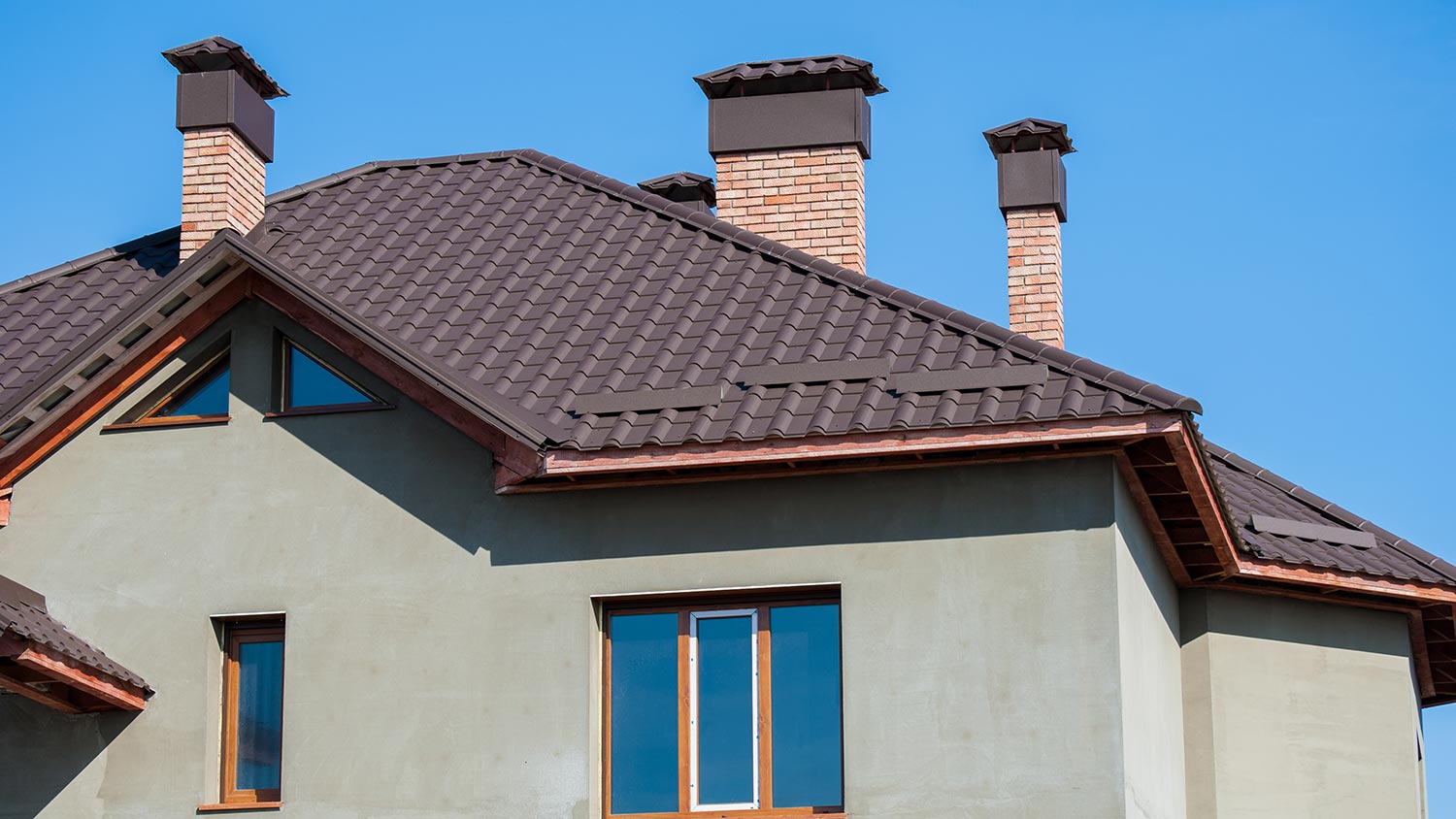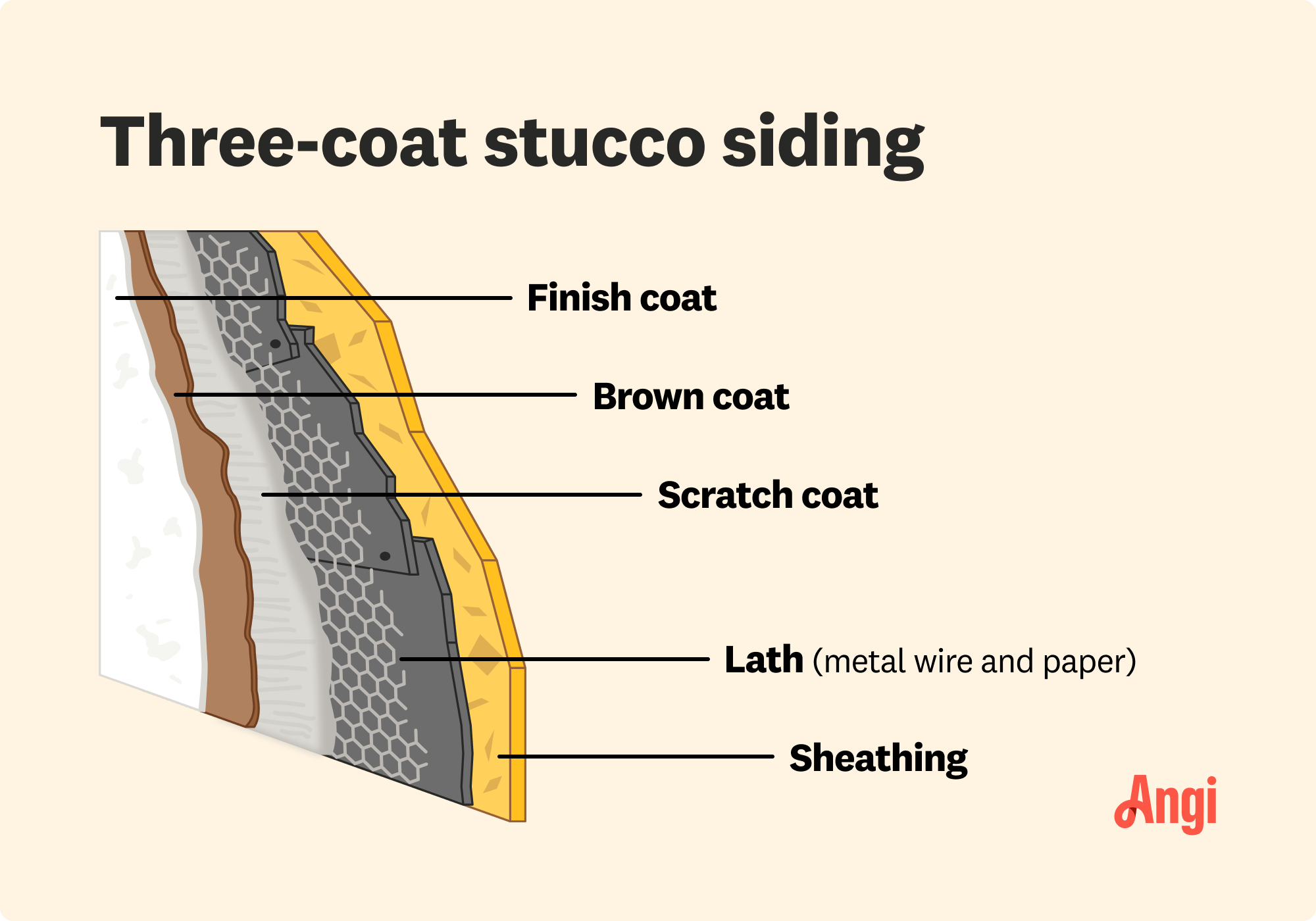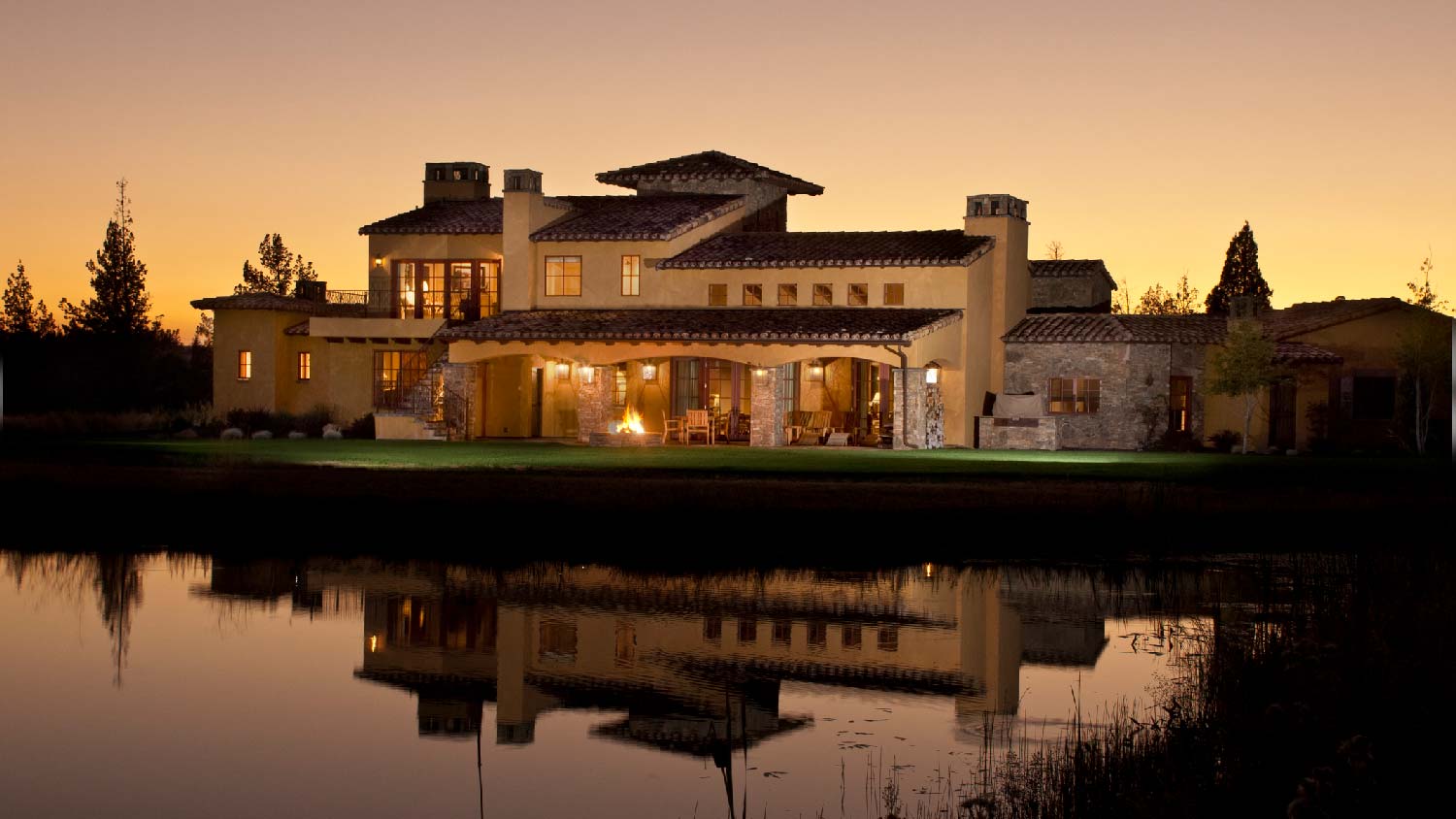
Get transparent stucco inspection cost info. Learn what impacts price, how to save, and what to expect before hiring a pro for your stucco inspection.
Checks off all the boxes, from cost to home protection


Stucco is a masonry product made of cement, lime, sand, and water, and its most common use is as a siding material.
Stucco is a durable siding option that can last for 50 to 80 years, on average.
Stucco is best in dry areas, but opting for EIFS siding, which drains moisture, is an option in moderate climates.
Stucco costs between $7 and $9 per square foot, depending on the type of stucco you choose and the finish.
What is stucco, and what makes it such a popular siding material? Stucco is a masonry product that is most commonly used as a siding material but can cover interior surfaces, as well. There are multiple ways to apply stucco, from a simple one-coat system to a more complex but durable EIFS siding system. Understanding what this material is and how it functions can help you decide if it’s a good siding option for your home.
Stucco is a construction material made from a mixture of Portland cement, sand, lime, and water. It most commonly serves as siding, but it can also be a decorative option for finishing interior walls. During application, it’s easy to work with and mold to get different textures, and when it hardens, it’s very durable, making it an ideal canvas for unique designs and colors while being sturdy enough to stand the test of time.
Most applications call for three coats of stucco for exterior uses, but it’s possible to apply a single coat in some circumstances. More modern EIFS siding includes three coats of stucco but three additional layers behind them to deal with moisture that penetrates through the porous material.

One of the most compelling pros of stucco is that it does an excellent job of insulating your home. Stucco is an ideal siding choice for homes in hot, dry climates such as Arizona, Nevada, and New Mexico, where it can boost home energy efficiency but also isn’t subject to a lot of moisture, which can damage the material and cause cracks and mold over time.
Stucco also has a natural resistance to fire and pests, so it’s a popular siding material in areas where wildfires are a threat.
Finally, stucco boosts home value and curb appeal, especially in areas where it’s a popular siding material.
Stucco lasts for 50 to 80 years, on average, and with good maintenance in a dry climate, you can easily get 100 years or more of useful life from this siding material. This puts it among the most durable siding options, and with a more reasonable up-front cost than brick or stone, it can offer more long-term value than most other materials.
There are three common types of stucco—traditional, synthetic, and acrylic—as well as a less common option for historical homes—lime stucco.
This type of stucco is a combination of Portland cement, sand, lime, and water. Though it’s water-resistant, it will absorb moisture and can develop cracks over time, especially if the water that gets in freezes. On the bright side, it’s also easier to repair than synthetic options, and it’s more affordable.
Unlike traditional stucco, synthetic (or acrylic) stucco includes resins and polymers, which increase the water-resistance and make it a better option in rainy areas. It’s more expensive than traditional stucco, but it also tends to last longer.
Acrylic stucco is a type of synthetic stucco that specifically uses acrylic resins for improved protection against moisture and water. It’s more expensive than traditional stucco, but it lasts longer and requires less maintenance.
Lime stucco is made from lime, sand, and water, so it’s like traditional stucco but lacks the addition of cement. This type is no longer popular in construction, and it’s mostly used to restore historical homes.
There are a handful of ways to apply stucco, and each comes with several pros and cons.

The traditional stucco application consists of three coats, as well as a backing to improve adhesion and water-resistance:
Wire (also known as lath) and waterproofing paper
A scratch coat
A brown coat
A finish coat
Three-coat stucco is twice as thick as one-coat stucco and much more durable, too. On the downside, it takes much longer to apply and cure, and the extra time and materials will usually be reflected in what you pay.

Single-coat stucco is more common on interior walls or when you use it for decorative purposes only, as it has less water resistance and isn’t ideal for siding in most areas. It consists of waterproofing paper and a lath, which you cover with a single coat of stucco. It’s an inexpensive alternative because it requires fewer materials and less time to apply and cure, but it’s also much thinner and, as a result, not as protective.
This is a newer form of stucco application that consists of up to six layers and includes synthetic, rather than traditional, stucco.
Water-resistive barrier: This is usually a liquid application that goes directly on your walls and provides protection from moisture.
Drainage plane: This layer helps drain any water that soaks through your stucco, reducing the risk of it damaging the materials behind it.
Insulation board: A rigid foam insulation boosts energy efficiency and helps make your living space more comfortable.
Glass-fiber mesh: This gives the stucco a textured surface to adhere to.
Base coat: The first coat of stucco, which acts as the scratch coat in a three-coat system.
Finish coat: This coat can include color and texture for a customizable appearance.
EIFS siding is more expensive than traditional or one-coat applications, but it can provide extra insulation to your home, improve water resistance, and is less likely to lead to stucco cracks you need to worry about.
There are a few key upsides to stucco that may help you decide if this is the right siding material for your home.
New stucco siding can improve your curb appeal and home value. You can choose from a range of stucco finishes that will give you the texture and color you desire for a seamless and unique appearance.
Stucco is a highly resilient material that can, depending on environmental conditions, withstand fire, impact, mold, rot, and termites. Its only real kryptonite is moisture and water, but in dry climates, it can last for up to 100 years with proper maintenance.
Stucco siding is usually between 3/8- and 1-1/8-inch thick, and that thick layer of cement adds some serious insulation to your home. Stucco boosts your home energy efficiency more than most other siding options, especially if you choose an EIFS system that includes an additional layer of exterior insulation.
The thick siding can also serve as an effective noise barrier, which is great for homes near high-traffic areas.
Traditional stucco is made from natural materials, meaning it’s more sustainable than vinyl, engineered wood, fiber cement, and several other siding options.
Stucco is ideal for some homeowners, but choosing this siding does come with some downsides, too.
Installing stucco siding costs between $7 and $9 per square foot, with most of that going toward labor. This makes it a more expensive option, at least in most cases, than vinyl, engineered wood, aluminum, and even fiber cement siding, and it puts it on par with brick veneer and stone veneer. It’s also challenging to DIY, so most homeowners opt for professional installation by a local stucco contractor.
Stucco’s rigidity once it cures is partially what makes it such a durable material, but it also means that any flexing can lead to cracks. Stucco expands and contracts slightly with temperature and humidity changes, and you can see cracks form as a result of that movement. Soil movement under your foundation can also lead to cracking, which can be expensive to repair.
As a porous material, stucco is prone to water retention, which can lead to water damage over time, especially if an incorrect application or a lack of stucco maintenance occurs. That moisture can lead to mold growth, and it can also promote rotting or pest infestation behind your stucco siding, potentially causing structural damage if you live in an area that sees heavy rainfall.
Stucco lasts a long time, but you’ll have higher maintenance requirements than you would with most other siding types. Your siding repair costs will be higher than they would be with vinyl, fiber cement, engineered wood, and even brick and stone.
If you're comparing stucco vs. plaster, the latter is a lot more versatile. Plaster is made from gypsum, lime, aggregates, and water, while stucco includes cement instead of gypsum. Stucco is more durable, but plaster is easier to work with.
Plaster doesn’t require as much preparation before application, and you can easily apply it to many different kinds of surfaces, like drywall and concrete. Stucco is an option for interior walls, but it’s most common as a siding material.
EIFS, which is shorthand for “Exterior Insulation and Finishing Systems,” is a wall system that usually includes synthetic stucco as the top two layers. EIFS is made by layering synthetic materials such as polystyrene foam board and fiberglass mesh with waterproofing membranes and multiple layers of stucco.
Given its layers, EIFS can be difficult to install; it’s also more expensive than a standard three-coat stucco system. Given its insulating properties, however, EIFS can be an excellent choice for homeowners who live somewhere with extreme climates. Places with high humidity and rain are better served by EIFS, as it drains moisture and includes additional layers to protect the materials behind it.
There are several siding alternatives to stucco to choose from. When deciding which is right for your home, be sure to weigh cost, durability, maintenance requirements, and other factors.
Vinyl lap: Made from layered plastic, vinyl lap is a simple and inexpensive alternative to stucco, and it stands up much better to constant exposure to moisture.
Fiber cement: Fiber cement is durable, weather-resistant, and low-maintenance; however, it can be more expensive than stucco, and it has a longer lifespan.
Stone: If you like the rustic, organic look of stucco, consider stone, which is even more dramatic; while more expensive, stone is extremely durable, requiring minimal maintenance and lasting for 100 years, on average.
Brick: Another versatile material, brick is known to last 50–100 years and pairs with almost any style of home. It’s more expensive than stucco but requires less maintenance.
It’s possible to DIY stucco siding, but it does demand some experience and patience. Getting stucco to look good—especially with a smoother finish—will be a challenge for most DIYers, and any mistakes can lead to leaks, problems with mold, and even structural damage.
Hiring a local professional who does stucco will cost more than doing it on your own, but it’ll leave you with a beautiful home and ensure you don’t run into problems with leaks or other damages prematurely.
The cost to hire a pro to install stucco ranges from $2,200 to $9,100, with an average cost of $5,700. Your total will depend largely on your home size and the complexity of the layout. Some other cost factors include the number of stories your home has, the type of stucco application you want, and the stucco texture and coloring you’re looking for.
From average costs to expert advice, get all the answers you need to get your job done.

Get transparent stucco inspection cost info. Learn what impacts price, how to save, and what to expect before hiring a pro for your stucco inspection.

Discover the cost to stucco a house in 2025, including average prices, key factors, and tips to help you budget and plan your stucco project with confidence.

Discover the average stucco repair cost, key price factors, and ways to save. Get expert tips to budget your stucco repair project with confidence.

Fire-resistant siding can protect you and your home in the event of a wildfire. Learn if stucco is fire-resistant and how it compares to other materials.

Love the traditional look of stucco but want to DIY your siding? We’ve got you covered. Learn how to stucco a house for a clean finish and maximum curb appeal.

Tired of that old, moldy stucco? Learn how to remove stucco siding the quick and easy way to save a few thousand dollars on siding removal costs.